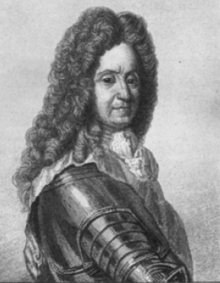| Camille d'Hostun | |
|---|---|
| Duke of Tallard | |
 | |
| Full name | Camille d'Hostun de la Baume |
| Born | 14 February 1652 Dauphiné, France |
| Died | 20 March 1728(1728-03-20) (aged 76) Paris, France |
| Spouse(s) | Marie-Catherine de Grolée |
| Military career | |
| Allegiance | |
| Rank | Marshal of France |
| Wars | |
| Awards | |
Camille d'Hostun de la Baume, duc de Tallard (14 February 1652 – 20 March 1728) was a French nobleman, diplomat and military commander, who became a Marshal of France.
Military career
Tallard was granted a commission in the French army at the age of 15. He later served under the prince de Condé in the Netherlands, and from 1674, under Turenne in Alsace. He was promoted maréchal de camp in 1678, and served in the Nine Years' War (1688–1697).
His friendship with King Louis XIV ensured a position of authority. After the war he served for two years as ambassador to the Court of St. James's, where his exceptional knowledge of European political affairs proved highly valuable. When King James II died in September 1701, King Louis recognised James's son as his successor to the throne of England. Consequently, King William III expelled Tallard from London in 1702.
Tallard's military career reached its height during the War of the Spanish Succession. On 7 September 1703 the Duke of Burgundy and Tallard took the town of Breisach. Tallard proceeded to attack Landau in mid October. A relief force under the Prince of Hesse-Kassel (or Hesse-Cassel) was roundly defeated by Tallard's force at the Battle of Speyerbach on 15 November. As a result, Landau fell two days later. Shortly after, Tallard was created Marshal of France.
In 1704, Tallard was sent to reinforce Maximilian II Emanuel's and Marshal Marsin's Franco-Bavarian army on the Danube, which was under threat from the Duke of Marlborough's and Prince Eugene's allied army. Tallard set out on 1 July from Strasbourg, but although the six day siege of Villingen proved abortive, (abandoned on 22 July), the French Marshal was able to bring 34,000 men through the Black Forest, reaching Ulm on 5 August.

Tallard was placed in overall command of the combined Franco-Bavarian army, but the subsequent Battle of Blenheim on 13 August 1704 resulted in complete destruction of his forces. Decisively beaten, he was captured and taken back to England and housed on parole in Chatsworth, Derbyshire and Newdigate House Nottingham. The writer Daniel Defoe reported that his small, but beautiful parterre, after the French fashion was one of the beauties of Nottingham.
During his stay in Britain, he is credited with introducing celery to English cuisine.
Later life
On his release in 1711 he returned to France. Despite the calamity of Blenheim, Louis appeared to bear the Marshal no ill will. Tallard was made a duke in 1712 and became a Peer of France in 1715. In King Louis XIV's testament, Tallard was appointed to the Council of Regency but the duc d'Orléans had the testament nullified. He was elected president of the Académie des Sciences in 1724 and, in 1726, he became a French minister of state. He died in 1728.
Family
He married Marie-Catherine de Grolée de Viriville-La Tivolière and had one son;
- Marie Joseph d'Hostun de La Baume-Tallard, Duke of Hostun, Duke of Tallart, (b.1683 - ?) he married Marie Isabelle de Rohan, daughter of Hercule Mériadec, Duke of Rohan-Rohan and Anne Geneviève de Lévis, daughter of Madame de Ventadour. The couple had no children; Marie Isabelle was the Governess to the children of Louis XV from 1735-1754.
Notes
- ^ Falkner: Blenheim 1704: Marlborough's Greatest Victory, p. 104
- Churchill: Marlborough: His Life and Times, p. 426
- Lynn: The Wars of Louis XIV, 1667–1714, p. 285
- Also spelled Spire, Speyer, Spirbach or Speyerbach.
- Chandler: Marlborough as Military Commander, p. 136
- CHATSWORTH, from Rev. John Marius Wilson's Imperial Gazetteer of England and Wales (1870-1872) online at visionofbritain.org.uk (accessed 14 November 2007)
- "A tour thro' the whole island of Great Britain: Letter 8, Part 1 (The Trent Valley)". Visionofbritain.org.uk. Retrieved 2012-03-16.
- The French prisoner who taught us to eat celery
- Tincey: Blenheim 1704: The Duke of Marlborough's Masterpiece, p. 88
References
- Chandler, David G. Marlborough as Military Commander. Spellmount Ltd, (2003). ISBN 1-86227-195-X
- Churchill, Winston. Marlborough: His Life and Times, Bk. 1, vols. i & ii. University of Chicago Press, (2002). ISBN 0-226-10633-0
- Falkner, James. Blenheim 1704: Marlborough's Greatest Victory. Pen & Sword Books Ltd, (2004). ISBN 1-84415-050-X
- Lynn, John A. The Wars of Louis XIV, 1667–1714. Longman, (1999). ISBN 0-582-05629-2
- Tincey, John. Blenheim 1704:The Duke of Marlborough's Masterpiece. Osprey Publishing Ltd, (2004). ISBN 1-84176-771-9
External links
- Tallard in Nottingham Archived 2016-03-03 at the Wayback Machine
- Free scores by Camille d'Hostun, duc de Tallard at the International Music Score Library Project (IMSLP)
- 1652 births
- 1728 deaths
- Dukes of Tallard
- Marshals of France
- French military personnel of the Nine Years' War
- French army commanders in the War of the Spanish Succession
- Members of the French Academy of Sciences
- 18th-century French people
- 17th-century French people
- 18th-century peers of France
- Peers created by Louis XIV
- People of the Regency of Philippe d'Orléans